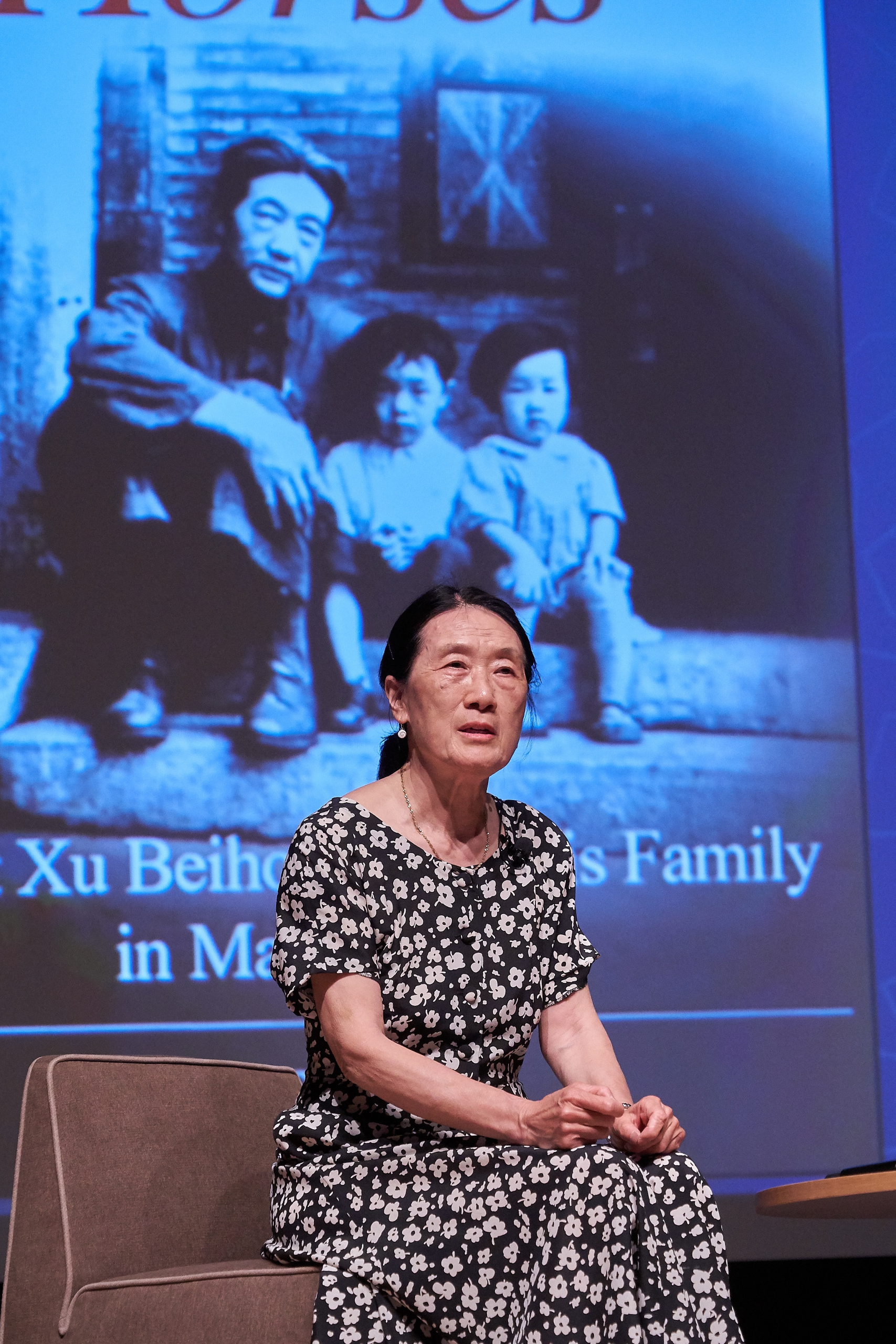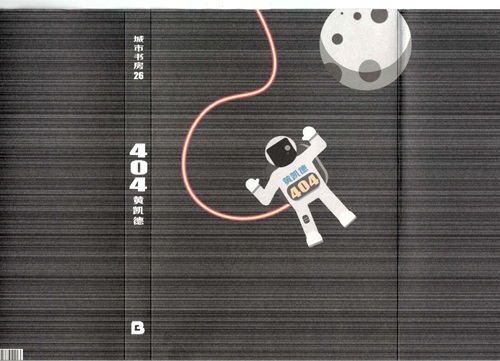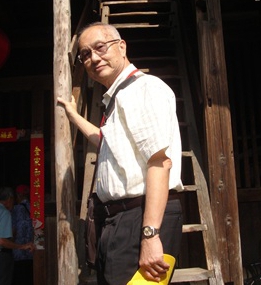《我的父亲徐悲鸿》讲座
文图·吴明珠 图·新加坡华族文化中心

徐芳芳出中英文书叙述文革时期家人的遭遇(新加坡华族文化中心供图)
五月三日晚上,画家徐悲鸿的女儿徐芳芳在新加坡华族文化中心主讲“我的父亲徐悲鸿”。讲座上徐女士以流畅的英语介绍她父亲徐悲鸿的作品,通过徐1930及1940年代的水墨与油画作品的幻灯片分析他的创作风格。讲座的主办单位是新加坡华族文化中心、新加坡国家美术馆及新加坡管理大学。
徐女士 (71岁)说,徐悲鸿 (1895-1953)是现代中国绘画之父,也是20世纪中国最有影响力的美术教育家。徐悲鸿为中国的画家与美术教育家提供了一个新的方向。
徐悲鸿以马画闻名于世
她以徐悲鸿于1938年创作的《马(无题)》(129.5×75.5 cm)为例子说明他如何描绘健硕而饱满的马匹。笔下的马鼻孔圆润而宽大,胸肌挺健,这幅画最特出的技巧是画家有意把前腿拉长,使马腿显得修长有劲。这种画法叫做foreshortening,是西化的技巧。她说徐1930 年代曾经在印度住过,有一次从大吉岭一路骑马到克什米尔。他发现印度马很特别,宽鼻子长腿,他很喜欢。回来以后他画的马显得特别的高大雄壮,并以画马闻名于世。
通过人物画描绘民族精神
芳芳说除了马以外,她父亲的人物画也赢得许多艺术爱好者的欣赏,有浓厚的人文气息。她列举几幅人物画说明。第一幅是1940年创作的大型油画《愚公移山》。愚公移山是中国一个神话,讲一个老头因两座山挡住他的大门口,立志将山铲除。他知道自己做不到但希望他的后代能继续努力。徐悲鸿这一幅画要表达一种坚强的奋斗精神。《愚公移山》是水墨画的一个大突破:画家成功地运用西画的素描技巧表现人物的精神。
第二幅重要的水墨人物画是《巴人汲水图》(1937)。那时候徐悲鸿住在重庆嘉陵江北的乡下。工作地点在重庆大学松林坡,每日乘船来往嘉陵江两岸。《巴人汲水图》的创作,画家一笔挥就,没有底稿。她说,中国画要求画家有敏锐的的观察力,每一根线条,每一片墨一下笔就不能修改。这幅画成功地捕捉汲水工人艰苦的劳作。这是徐早期以劳动人民为主题的作品之一,也是他的写实绘画风格代表作之一。
然而更全面地展现徐悲鸿油画技巧的作品要算是《田横五百士》(1930)。田衡是秦末齐国的贵族,因不愿称臣于汉而自尽,他手下的500位壮士知道以后也跳海自尽。画家在创作时以现实中的人物为参照。其中站在第一排,身穿黄衣的人就是他自己。这幅画暗喻日本侵华时中国人奋勇抵抗的精神。
动物画栩栩如生
徐女士说父亲不止能创作栩栩如生的人物画和马画,画其他动物也一样能细致地表现它们的特性。比如1938年创作的淡彩中国画《负伤之狮》。当时日军入侵中国,人民苦不堪言,画家以强劲有力的线条画雄狮的身体,它以回首的姿态,双眼炯炯有神,似乎在向日本侵略者怒目瞪视。其他优秀的水墨作品包括:《杜甫诗意》(与张大千合作)、《漓江春雨》、《萧声》、《牧童与牛》、《虎与兔》及《甘地》。
徐悲鸿 (原籍江苏)于1919年考入巴黎国立美术学校学油画和素描。他是第一个把油画和素描技巧引进中国的画家。他认为画家应该表现生活而素描是重要的基本功。他在中央美院创立油画系,传授油画技巧。从1927到 1953年,他创办的油画系统培养了几代的油画家及美术教育家。 这一批画家或美术教育家为20世纪的中国绘画做出伟大的贡献。
廖静文抢救徐悲鸿最大的收藏
徐女士在讲座上也谈到于2016年出版的英文书《Galloping Horses – Artist Xu Beihong and His Family in Mao’s China》。她说,写这本书的目的在于:呈现真实的资料;向她的母亲致敬,让世人知道她在保留父亲重要作品及收藏方面所付出的心血。该书已经有中文版的电子书《奔腾的骏马:画家徐悲鸿和她的家人在毛泽东的中国》。(详情请上网:www.BeihongChinaArts.com)
出生于北京的徐芳芳是徐悲鸿第三任太太廖静文 (1923-2015)的女儿。父亲去世时她才6岁,哥哥徐庆平 (72岁)是徐悲鸿纪念馆馆长。她父亲去世以后,母亲把1200件作品和1000件古今名古书作品捐给国家,成立了徐悲鸿纪念馆。该馆收藏的徐悲鸿作品是全世界数量最大、水平最高的。文革期间母亲惨被殴打,徐悲鸿纪念馆险遭攻击。母亲向周恩来求救。周总理找人把纪念馆藏品运到故宫,在那里有解放军守护,国宝才得以保存。1966年8月纪念馆被拆,她又历经千辛万苦,纪念馆终于在1983年重建。她说如果没有母亲的努力,今天人们就没有机会欣赏到完整的收藏。她说,从 1949 年到1976 年,徐悲鸿在新中国任中央美术学院的院长和美术家协会的主席。当时共产党执政,要艺术家为人民服务。徐悲鸿尝试改变画风。他很支持新中国,但碰到很多困难。
徐悲鸿对孩子的期望
《奔腾的骏马:画家徐悲鸿和她的家人在毛泽东的中国 》也记录徐女士自己的事迹。她说父亲很疼爱她和哥哥,对他们的期望很高,希望至少有一个孩子能当画家。当哥哥5岁,她4岁时父亲要他们练习书法。芳芳自小在北京中央音乐学院附中修读钢琴演奏专业。文革前努力研修10年。文革时和哥哥一起下放。下放期间在农村干粗活的日子很苦,但她不放弃学习,偷偷地学英文,希望她的英文和音乐的知识能对后人有所贡献。她强调下放使她变得更坚强。
在结束讲座时,徐女士说父亲多次访新加坡办展览,认识了许多朋友,和这里的人建立了良好的关系。她希望她的讲座能激发东南亚的画家像徐悲鸿一样努力创作,也希望更多人能欣赏到优秀的艺术作品。
(作者为本刊特约记者)
MY FATHER XU BEIHONG
In the evening of 3rd May Madam Xu Fangfang, daughter of artist Xu Beihong (1895-1953), gave a talk on the art of her father at the auditorium of the Singapore Chinese Culture Centre. In fluent English she introduced the style of Xu’s Oil and Chinese paintings with slides of works created from the 1930s to 1940s. The talk was organised by SCCC, National Gallery Singapore and Singapore Management University.
Madam Xu (71) said her father was the father of modern Chinese Painting and the most influential art educator in modern China. She highlighted his techniques in creating robust horses with the method of foreshortening. The artist is known for his skills in painting horses world-wide. Xu’s figure paintings too are admired for their ability to reveal the inner spirit of the figures. An oil work titled “The Foolish Old Man who Removed the Mountains” depicts a legendary old man’s efforts in removing two mountains blocking the pathway to his home. The foolish old man knows he alone cannot achieve the aim but wishes his descendants would follow in his footstep with perseverance and hard labour. The painting, enhanced with the technique of sketching, is a break-through in modern Chinese Painting in that the artist succeeded in capturing the figures’ inner strength which serves as the symbol of perseverance of the Chinese people. Another painting titled “Tian Heng and His Five Hundred Warriors” depicts a Han Dynasty noble man who refuses to serve the Han leader. In the end he and his 500 warriors take their lives. The artist had modelled a figure in the painting in a yellow robe after his own image. Besides figure, his paintings of other animals like tiger, cat and lion are lively too and some of them serve as metaphors for the strength and unbeatable spirit the Chinese people displayed during the period of the Japanese invasion. Madam Xu also introduced some of his fine paintings of landscape and famous people such as Gandhi in the Chinese Ink Painting genre.
Xu graduated from the Ecole Nationale Superieure des Beaux-Arts in Paris in the early 1920s where he studied Oil Painting and Drawing. He then introduced both genres to students at the Central Academy of Fine Art in Beijing. Generations of artists had benefitted from his teaching methods.
Madam Xu’s recent publication of Galloping Horses — Artist Xu Beihong and His Family in Mao’s China pays tribute to her mother Liao Jingwen for her efforts in rescuing 1,200 paintings by him and 1,000 paintings in his collection and in having a Xu Beihong memorial Museum rebuilt. Fangfang relates her hard life in the country-side during the Cultural Revolution where her Piano Performance studies were interrupted. Despite the harsh conditions she worked on music and English language. She hopes with her talk people in South-east Asia would learn or enjoy good paintings as enthusiastically as her father did in creating the fine works.




带领新加坡商务考察团重返武夷山.jpg)
在印度合影(图源:Tan-Chong-Tee-Force-136).jpg)
